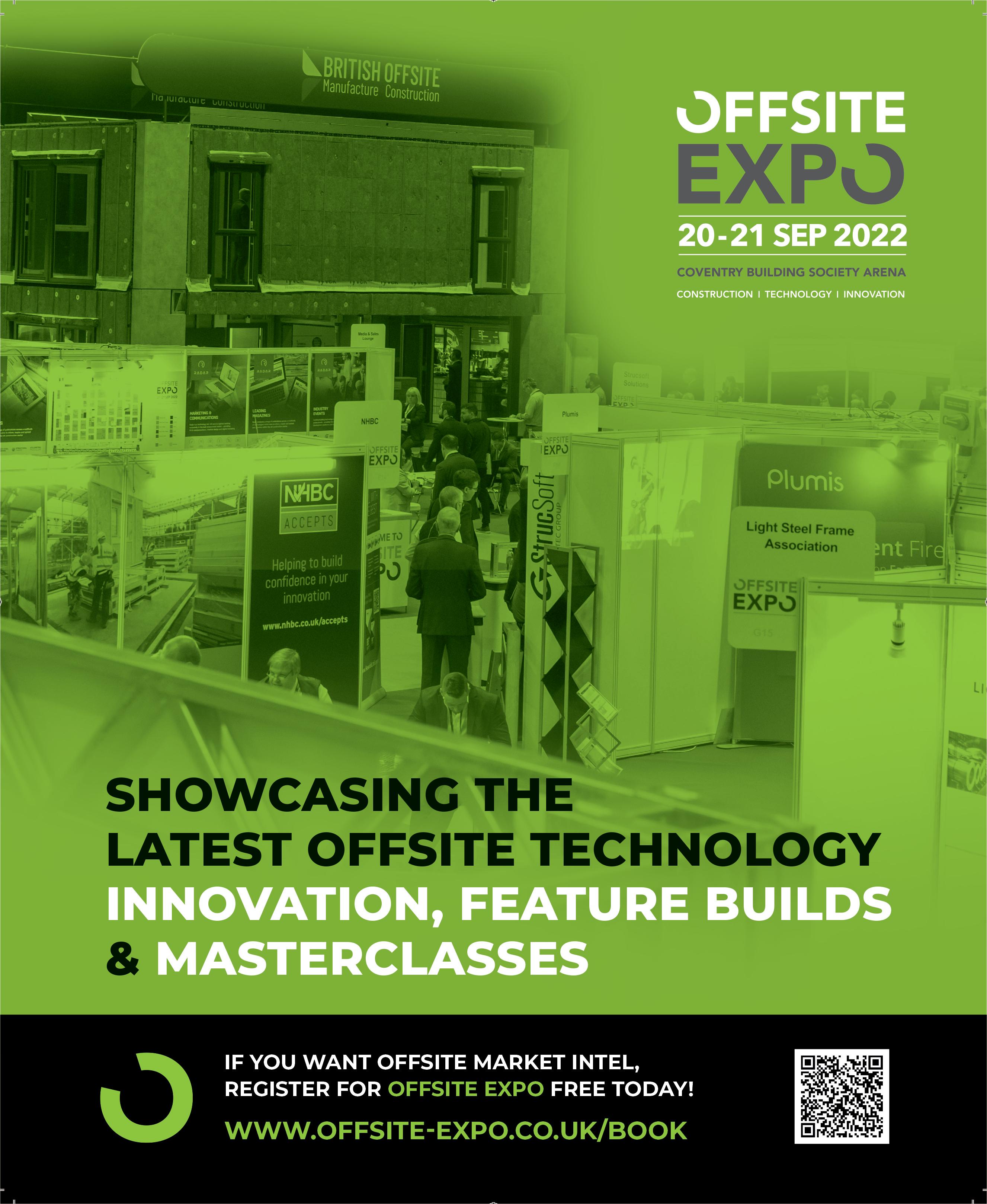
29 minute read
Digital Construction Awards
Digital leaders
The pioneering projects, teams and individuals were celebrated at this year’s Digital Construction Awards, organised by CIOB, DCW, CM and BIMplus and hosted by Russell Kane. Read on to find out about the winners
Advertisement

Sponsored by

Emma Hooper is Digital Champion of 2022
Emma Hooper, associate director and head of R&D at Bond Bryan Digital, is the deserving recipient of the Digital Construction Champion of the Year accolade, sponsored by Solibri
The Digital Construction Champion
of the Year award recognises an individual who has played a key role championing digital transformation on a project, in an organisation, or an industry sector, during their career.
Emma Hooper, this year’s winner, has been championing the use of BIM and digital innovation across the built environment for many years. After graduating with an architecture degree, she joined fit-out specialist Styles & Wood, where her interest and involvement in digitalisation began to blossom. From there, she took a role as BIM technologist at Metz Architects, before joining consultant Bond Bryan Digital, where she is now associate director and head of research and development.
Along the way, Hooper has become an active and authoritative member of the wider digital construction community. She is especially passionate about IFC – the standard for open BIM data exchange – and has been on a mission to get everyone speaking the same data language.
She is a member of the BSI B/555 committee for BIM standards, part of the BuildingSMART UK & Ireland committee and an ambassador for the UK BIM Alliance. She is also one of only 10 people in the world certified as being proficient in COBie.
Her work has helped make construction projects more efficient by joining up the dots between people, process and technology to enable true collaboration with an emphasis on open linked data.
When reviewing the judges’ nominees for this category, there was one name at the top of everyone’s list. With her enthusiasm for the industry and the people working within it, not to mention her exceptional technical knowledge and expertise, Emma Hooper is our Digital Construction Champion of 2022.
On receiving the award, Hooper said: “When they said she championed open standards, I was, ‘oh my god’. I was really shocked – I wasn’t expecting it at all.”
Emma Hooper receives her trophy as Digital Champion of 2022 from host Russell Kane (far right) and Andrew Bellerby (second left) from sponsor Solibri Emma is at the forefront of the digital revolution, delivering better information management for her clients while simultaneously researching and developing strategies that will benefit the whole industry
What the judges said

Sponsored by

DCT and Collen take Partnership prize
Digital Construction Technologies and Collen Construction worked together to develop and deploy an onsite ‘BIM cave’, The Digital Cube. It was the clear winner of the Partnership category, sponsored by Bluebeam
The senior management teams
of BIM consultancy Digital Construction Technologies (DCT) and main contractor Collen Construction recognised that in working together they were not extracting the maximum benefit from digital tools. Office-based engineers excelled in digital tools while site-based staff were not only unable to use some technology, but were losing out on developing their digital skills.
So DCT and Collen set about creating the Digital Cube, an onsite ‘BIM cave’.
DCT and Collen describe the Cube as “an office environment with the latest touch-activation systems by Avitor networked back to the cloud. The Cube enables both site team and office team to overcome the challenge of collaboration and work cohesively at the coal face where they are most effective, with real-time digital information and coordination platforms.”
Software available in the Cube includes Navisworks, Bluebeam and Nureva Span Wall.
On the 20,000sq m data centre project on which the Cube was tested, a cumulative saving of 3,000 people hours was estimated over the 18-month construction period, thanks to the immediate onsite availability of the Cube’s digital tools.
The use of the Cube was not limited to DCT and Collen – key subcontractors were trained in its use too.
Joseph Mady, CEO of DCT, reflected on winning the award: “It did and it didn’t surprise me [that we won]. The way we’ve integrated the software and the hardware enables anybody to work in the middle of a field and move from 2D to 3D and back.”
Digital Construction Technologies and Collen Construction receive their trophy from host Russell Kane (far right) and Matt Burke (third left) from sponsor Bluebeam.
Simple yet hugely affective. The team had very clear goals and benefits; tangible solution with a strong focus on people engagement; great client/ contractor collaboration
What the judges said Other shortlisted organisations
l Bespoke fitted seating – Future Joinery Systems with South West Upholstery, 4D Routing, Sydenhams CNC l Clarice Pears Institute of Health & Wellbeing building at The University of Glasgow – Qualis Flow with Multiplex and Zero Waste Scotland l Goldeni’s IoT influencing the design and fit out for commercial offices – Morgan Sindall with Goldeni and Microsoft l The Forge – Landsec, Sir Robert McAlpine, Mace and Bryden Wood l University of Glasgow ARC Research Hub – Multivista with Multiplex

Sponsored by BIMPLUS
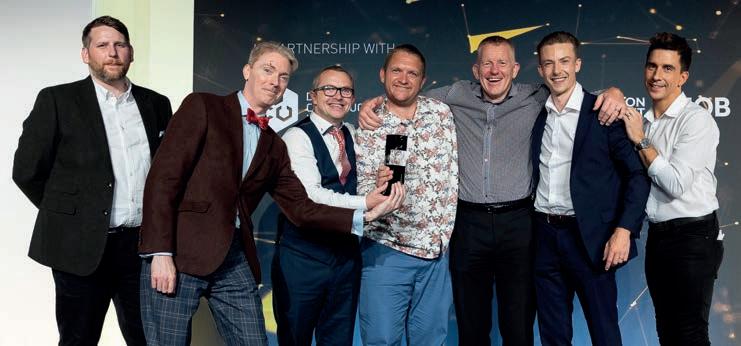
The MWH team receive their award from host Russell Kane (far right) and sponsor Justin Stanton of BIMplus (second left)
MWH Treatment wins Digital Innovation in Design
MWH Treatment’s digital strategy on the Thames Gateway (Desalination) Recovery Project facilitated collaboration and stakeholder engagement and secured victory in the Digital Innovation in Design category, sponsored by BIMplus
MWH Treatment was part of the
SMB joint venture with Skanska and Balfour Beatty that was contracted by Thames Water to work on this project at the UK’s only desalination plant.
The JV was tasked with making health and safety improvements, optimising maintenance procedures and consumable storage, and creating further efficiencies across the desalination process as part of a £23m investment.
The process is complex compared with a conventional water treatment plant, and limited data on existing assets or operational records were available at the outset. To address these challenges, MWH Treatment developed a digital strategy to facilitate a collaborative approach, centred around its MView software, which was piloted on the project.
The digital journey started with a BlueSky aerial photogrammetry 3D model, used to generate the animation to communicate scope and hazards to stakeholders. The model was enhanced through 3D scanning, which provided point cloud data to support detailed engineering design.
MWH Treatment digitally validated the specification, condition and function of every asset and control system on the site. Asset data was collected in an app-based Autodesk BIM360 cloud database. A bespoke software test rig was built to verify existing processes and fault-find.
The data gathered was fed into the engineering design and plant optimisation. Using MView, the design team created 3D animations that simulated water treatment processes. The simulations integrated process calculations and safety factors to visually demonstrate root causes of process failure.
Where solutions required heavy construction and logistics, 4D simulations were used to visualise the build programme and methodology to support collaborative planning.
Padraig McCormack, digital delivery manager, put their success down to “our ability to think outside the box, innovate, and our great technologists who take the gaming side of the software development and utilise that in construction to break the boundaries of what we can do”.
Other shortlisted organisations
l Analysing human emotional responses to building and space design – Chetwoods l East Bank, Queen Elizabeth Olympic Park – Allies and Morrison l East Wick & Sweetwater – astudio & Etude l Frilford Heath Staircase and Cabinetry – Future Joinery Systems with Casa Architects, JPT Carpentry, 4D Routing and Sydenhams l LightSIM Controls App – Hoare Lea
MView sounds like it has been a game changer, providing analysis to drive optimal design, which also mitigates health and safety risks. It will be interesting to see how this develops

Sponsored by
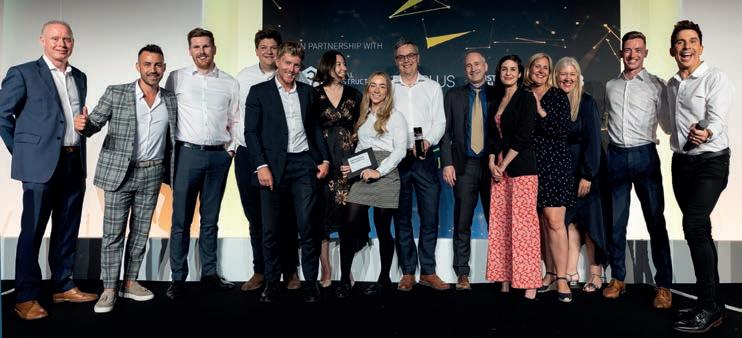
The Forge scoops Project of the Year
The Forge, where Sir Robert McAlpine and Mace worked with client Landsec and designer Bryden Wood, was the clear winner of the Digital Construction Project of the Year category, sponsored by Revizto
Digital tech underpinned the ‘kit of
parts’ approach known as platform DfMA (design for manufacture and assembly) on this £95m, 150,000 sq ft office project in Southwark, London.
As client Landsec’s appointed MAM (manufacturing and assembly manager), main contractors Sir Robert McAlpine (SRM) and Mace collaborated with architect Bryden Wood to deploy a huge range of digital tools.
These included: l Disperse – 360 photo capture and automated progress reporting using AI; l Converge – concrete strength monitoring, using live data from wireless sensors monitored by AI, which reduced strike times; l Qflow – monitoring of waste and deliveries, with real-time reporting of waste removal non-conformance; l Material tracking, with QR codes tracking the Comflor beams used in the frame construction; l iFire – a fire-stopping monitoring tool to ensure the fire integrity of the building with a clear audit trail; and l Robotics – BIM models linked to robotic welding machines to create temporary works kit.
Others included Datascope site access control, Dalux BIM model viewer for all stakeholders and Glider’s BIM asset information model, with trade contractors exporting models to comply with required COBie outputs.
The MAM team, working with software vendors, provided training to staff and key trade suppliers, creating a skills legacy for future projects. The open-source data generated means the learning from the digital tool suite can be shared across the wider industry.
Construction delivery required 20% fewer site operatives than for a traditional project, while the finished project achieved a 25% reduction in embodied carbon. The Forge becomes the first UK commercial building to be net zero carbon both in construction and operation.
Padraig Delaney, region digital construction lead for Sir Robert McAlpine, said: “They trusted us to deliver their innovation project, so we had to get the right culture embedded.”
A comprehensive assessment of digital tools and their application – a strong step forward for the sector. Very good people engagement with a focus on sharing knowledge
The Forge project team from Sir Robert McAlpine and Mace receive the project of the year award from host Russell Kane (far right) and sponsor Rhys Lewis of Revizto (second left)
Other shortlisted organisations
l Advanced Research Centre, University of Glasgow – Multiplex, University of Glasgow, HOK Architects, WSP l East West Rail Alliance, Bletchley Flyover – Atkins, Laing O’Rourke, Network Rail, VolkerRail l Thames Gateway (Desalination) Recovery Project, MWH Treatment – Skanska, Balfour Beatty, Mott Macdonald, Thames Water l The Christie at Macclesfield – Vinci Construction l Transpennine Route Upgrade West – Network Rail, BAM Nuttall, Arup, Amey

Sponsored by
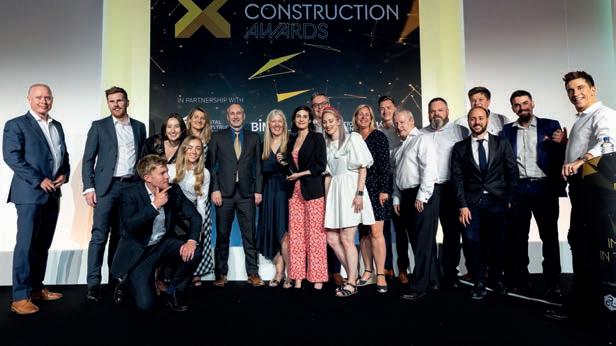
The Forge takes Offsite gong
The Forge office project is pioneering proof of a platform design for manufacture and assembly strategy. Its team of Bryden Wood with Landsec, Sir Robert McAlpine, Mace and NG Bailey secured the Digital Innovation in Offsite Construction category, sponsored by CM
The Forge, a 139,000 sq ft office
in Southwark, London, is Landsec’s demonstrator project for its platform design for manufacture and assembly (DfMA) strategy.
The ambitious targets for Landsec’s strategy included increased safety and collaboration, lower capital cost, reduced waste, a shorter programme and the use of fewer operatives.
To achieve these goals would require a comprehensive approach to design, procurement, manufacture and assembly, with a digital eco system that could combine numerous tools in an integrated workflow.
Bryden Wood ran two teams in parallel through to RIBA Stage 3: one using traditional methods and the other using platform DfMA. The latter was chosen. This demonstrated that DfMA could be used for 80% of the project.
The project brought together new and existing technologies, linked through a central ‘spine’ of data, to ensure offsite benefits were transferred on site and evidencebased learnings were gathered to take on to future projects.
Elements included: l platform design – the digital library of components had the construction process built-in, including integration of superstructure with temporary works, facade and MEP; l algorithmic design – the library includes predefined interfaces and relationships facilitating automated design; l cassette design – a workflow linking design to fabrication and logistics models ensured close coordination, each cassette having a unique identifier linking all key information and exact specifications; l digital delivery – the likes of Qflow, Disperse and Converge were integrated to maintain the digital golden thread from design and manufacture into assembly; and l automation – a range of machinery was prototyped and/or used for the first time in construction to create factory-like assemblies.
Ultimately, Bryden Wood’s approach generated: l a 2% increase in net lettable area (and an entire basement removed); l improved safety (no work at height, no work in concrete); l a 50% reduction in site operatives for superstructure and facade; and l proof that a platform approach first adopted by the Ministry of Justice can be reused in other sectors.
Neil Pennell, head of design innovation and property solutions at Landsec, reflected on the reasons for the Forge’s win: “Because this is a team, and because we’ve really pushed the boundaries of innovation and brought something forward for the industry that will make the world of construction a better place. It’s all about the way you design, construct and deliver a building using digital tools within that process – combining them so they’re working together.”
The Forge Project team receive the trophy from host Russell Kane (far right) and sponsor Will Mann of CM (far left)
Other shortlisted organisations
l 33 Charterhouse Street – Prism & SES l KOPE: Mace HRS The collaboration and integration of alternative technologies and solutions to achieve the goal is impressive. It was a complex challenge with a great outcome
What the judges said
Sponsored by
Vinci wins Best Use of Data
Vinci’s clever use of data and AI at a cancer hospital project deservedly took top prize in the Best Use of Data category, sponsored by the UK BIM Alliance
Vinci Construction has made
impressive productivity gains through its innovative approach to using project progress data.
In March 2021, working with US firm OpenSpace, the contractor introduced 360 data capture for recording site progress. After the initial implementation, Vinci looked at how it could link this data to the construction programme in real time.
On the HCA cancer care hospital in Birmingham, Vinci used AI to convert 360-degree images into a measurable record of progress for project elements including concrete, internal walls, ceilings and building services. After testing this system, Vinci examined how it could use this data and the AI system to identify other construction efficiencies.
The standard process for updating the programme on the HCA project was a weekly site inspection taking each construction manager 3.5 hours per week and the planner six hours.
To increase efficiency, the digital team developed a ‘smart data connection’ (SDC). This automates
A great idea and the use of AI to extract data from the site provided real practical benefits. There was a people focus before it was launched, to get people to understand the ‘why’ first
data entry from any structured data source and connects this information into a new digital information hub, using Microsoft Azure infrastructure.
This only requires a weekly site walk. The AI platform’s productivity analysis is also saved as a record and used as a baseline in project planning.
The introduction of the SDC has followed Vinci’s ‘Digital Driven by Desire’ principles, where staff receive a demonstration of any new technology’s benefits before its introduction and are encouraged to propose changes and improvements.
The implementation of SDC has produced impressive gains for Vinci’s team at the HCA project, with a 60% efficiency improvement in time taken by construction managers for site inspections and a 50% improvement for the planner. Vinci also managed to reduce the construction programme from 113 weeks to 110 weeks.
Marco Bonelli, lead digital engineer at Vinci Construction UK, said: “We were able to save 60% on site inspections just by keeping data in one point and flowing it to different parts of the business.”

Other shortlisted organisations
l 51 Moorgate – Skanska UK l ARC (Automated Cable Routing Management System) – Bryden Wood with Transport for London l 360 real-time reporting – Multiplex l QFlow on SCS Railways – SCS Railways, QFlow, HS2 l The Forge – Sir Robert McAlpine, Mace, Landsec, Bryden Wood
The Vinci team receive their award from host Russell Kane (far right) and sponsor Casey Rutland of the UK BIM Alliance (far left)
Sponsored by
Atom AR headset is Productivity winner
XYZ Reality’s augmented reality Atom headset, which helps prevent delays associated with rework, was the winner of the Digital Innovation in On-Site Productivity category, sponsored by Procore
The Atom, XYZ Reality’s augmented
reality (AR) headset has been developed to overcome the persistent productivity problems affecting construction, particularly the reduction of rework through greater accuracy. AR is not new, but the Atom – and the HoloSite software which enables it – was developed from a construction, opposed to generic technology perspective.
Launched in November 2021, its AR capability means the wearer can see a visualisation of the as-built digital twin, 3D rendered, within 3mm-5mm accuracy. Site teams can be confident they are building to the correct specifications and real-time, in-situ inspections can be conducted during the build.
Project teams use HoloSite software to upload data from Autodesk Revit, Navisworks and other software, where it is converted into an XYZ format which plugs into The Atom. Data flow between The Atom and HoloSite allows site teams and the office to check if works are executed as detailed in the BIM model.
Cloud technology allows remote viewers to log into a live feed and troubleshoot issues. This reduces the need for travel to the site for inspections.
In a recent data project the tool was used by construction management firm PM Group during rainwater pipe installation. The Atom pinpointed multiple positional discrepancies in the surface water network connections and slab penetration positions – but before any major works were undertaken.
PM Group explained the issues to contractors who corrected the errors without significant delays. This saved over £250,000 and 3.5 weeks of predicted rework.
XYZ Reality supports the introduction of The Atom with staff training, onsite support and assistance in processing data.
Dan Houston of XYZ Reality said: “Traditionally in construction, there is a very reactive process using traditional means. We’ve shifted that mentality, because if you can see what you need to build, you get it right the first time. We’ve just scratched the surface of what we want to achieve.”
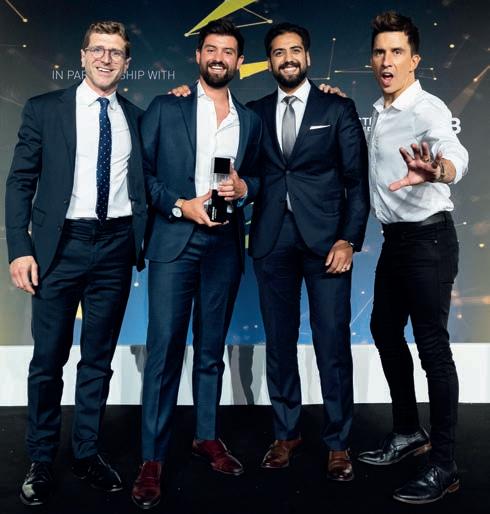
Other shortlisted organisations
l Black Potts Weir, Flood Alleviation Scheme – L Lynch, BAM Nuttall l Crane telematics – Skanska UK, Select Plant Hire l Digital progress tracking with automated reporting – Taylor Woodrow l SCS Railways JV work on HS2 – SCS Railways, HS2, Zutec l The Forge – Bryden Wood, Landsec, Sir Robert McAlpine, Mace, NG Bailey
The Atom offers impressive, multifaceted innovation. It offers a move away from a reactive approach to tackling errors, to a more proactive way of working and solving problems
The XYZ team receive their trophy from Russell Kane (far right) and Ben Douglass (far left) from sponsor Procore
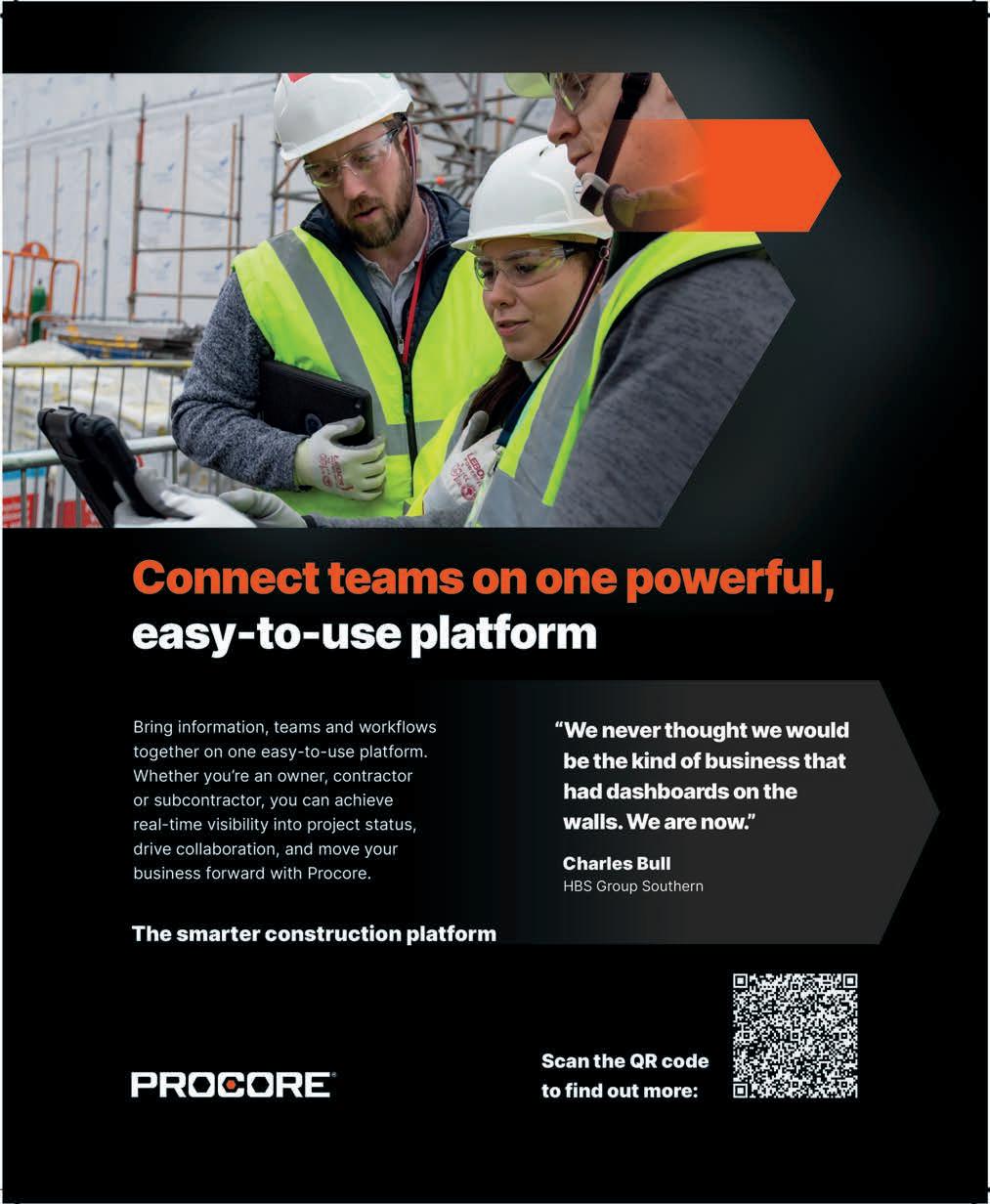
Sponsored by
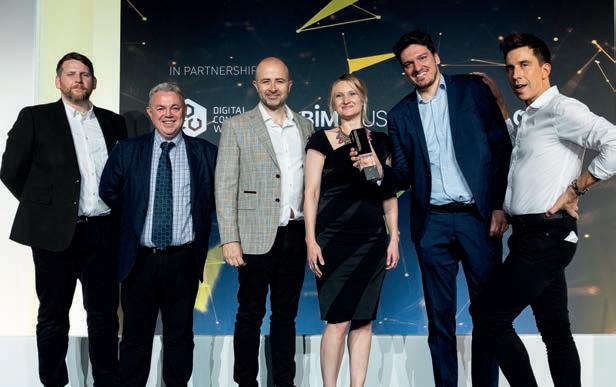
Visual 5D secures SME award
Visual 5D, which has brought gaming technology to builders’ bids, was named winner of the Digital Excellence in a Construction SME category, which was sponsored by the Chartered Institute of Building
Visual 5D was established with
the aim of supporting building contractors with an effective communication platform during the tendering stages of a project.
Tender meetings are often marked by underwhelming presentations that lack dynamic content and can be difficult to understand for a non-technical audience. In contrast, Visual 5D brings projects to life with detailed 3D animations of the construction schedule and site logistics for presentation.
The company uses gaming technology, combined with its own software, that links the start and completion dates from the programme schedule to an animated 3D model. This combination results in a ‘movie-style’ animation that combines the best of both worlds: high-quality visual graphics with technical data that accurately reflects the construction schedule.
Visual 5D’s platform allows the contractor to demonstrate that all construction stages have been rigorously planned and considered, with its 3D models providing granular detail and identifying unforeseen inefficiencies at the planning stages. As well as creating a ‘wow factor’ at tender stage, the technology effectively showcases the benefits of digitalisation.
To develop the system, Visual 5D had to undertake a training process to bridge the two worlds from which modellers typically come: l Construction - those experienced with BIM software such as Revit, Navisworks and Synchro, but with no experience of creative or gaming software; and l The gaming industry – those with experience of Cinema 4D or Lumion, but no experience in construction or of construction software.
The judges were impressed by the company’s focus on people and skills, in particular the development of a bespoke training process, which brought together experience and expertise from two industries.
In 2021/22, Visual 5D contributed to 13 winning construction bids with a total value of £3.8bn, among them work on the Houses of Parliament.
John Ferry, MD of Visual 5D, said: “We’ve put in lots of hard work to build our presence in the past 10 years, so it’s great to have this recognition.”
Other shortlisted organisations
l BIMBox l Cooper Moss Rutland LLP l MachineMax with HS2 and Align JV l Nuspan Flooring l Royal Free London Property Services (Capital Projects PMO reporting tool)
The Visual 5D team receive their trophy from host Russell Kane (far right) and sponsor David Philp (second left) of the Chartered Institute of Building
A huge part of selling the benefits of digitalisation sits in how we can best communicate those to people who aren’t technically minded. This solution is powerful in that respect. It will also act as a catalyst for skills development in the future. It is a very innovative and elegant solution to a perennial problem
What the judges said
Sponsored by
Lynch Plant Hire wins Net Zero category
Lynch used technology and engagement with its staff to meet targets set by the Skanska Costain Strabag JV on HS2, and thus secured victory in the Delivering Net Zero with Digital Innovation category, sponsored by Zero
Lynch Plant Hire’s client on the
south section of HS2, the Skanska Costain Strabag JV, asked it to reduce plant idling by 20% to improve the air quality for the community surrounding the construction site.
Lynch looked at its available resources, namely technology, data and its people. The development of its strategy began with its Eco Driver Training Programme, which blended telematics data with advanced operator training.
Lynch proposed to carry out a trial on site to identify the current idling and carbon emissions. In addition, it proposed to upskill and mentor 10% of its operators on site over three months. Lynch educated the operators on the importance of sustainable working and how they can impact fuel consumption and carbon emissions.
Furthermore, Lynch’s data showed that individual upskilling was more effective in reducing machine idling than group presentations. It designed a Green Leadership Board based on the idling improvement per driver and per machine type. This served as a friendly competition between the drivers, which ended up improving the overall results.
Lynch also presented the data results to each operator, which allowed them to become aware of their individual carbon footprint.
The overall goal was to move the driver idling percentage from red (above 60%), to amber (41%-59%) and then to green (below 40%).
The total average idling percentage for the focus group at the start of this exercise was 41% (amber). However, by the end of January it dropped to 24% (green). Additionally, the total CO2 consumption was 44,423kg in November, but 20,610kg in January – a 46% reduction.
A reduction in idling also leads to a substantial fuel cost saving for the client. The total fuel consumption was 17,124.6 litres in November and dropped to 7,944.9 litres in January.
Following the success of the programme, Lynch has made Eco Driver Training a mandatory module for all operators.
Paul Keenan, head of machine controls at Lynch, said: “It’s just a sensible thing to do, the whole idea of being net zero – and it creates a better environment for our operators.”
A great example of how data and technology can change mindsets and training to deliver real results. Few projects will show a more immediate reduction in greenhouse gases
Lynch’s team with Russell Kane (right) and Jonathan Munkley from Zero (second left)
Other shortlisted organisations
l Advanced Research Centre, University of Glasgow – Multiplex, University of Glasgow, HOK Architects, WSP l East West Rail Alliance, Bletchley Flyover – Atkins, Laing O’Rourke, Network Rail, VolkerRail l Thames Gateway (Desalination) Recovery Project, MWH Treatment – Skanska, Balfour Beatty, Mott Macdonald, Thames Water l The Christie at Macclesfield – Vinci Construction l Transpennine Route Upgrade West – Network Rail, BAM Nuttall, Arup, Amey

Sponsored by
Bryden Wood wins prize for Best Application of Technology
Bryden Wood’s automated cable routing management system, which has generated significant time savings for Transport for London, won the Best Application of Technology category, sponsored by Digital Construction Week
London Underground’s tunnels
are tight and cluttered. Plotting the most effective route for new cabling requires a detailed survey of the existing tunnel surface, and then meticulous planning to allow for a wide range of complex variables: in other words, a time-consuming and labour-intensive manual process that puts teams of people in difficult, dirty and dangerous environments, while also disrupting public transport.
Bryden Wood, working with Transport for London (TfL), has developed ARC: data-driven design automation technology for underground signal upgrades that makes cable routing faster, safer and smarter.
The ARC process starts with collation of as many input variables as possible to establish machinereadable rules. Then comes a point cloud survey of the tunnel, which is analysed. The rules then recommend the optimal routing of cables. ARC also outputs 2D information and 3D models offering various options for cable installation.
Bryden Wood and TfL successfully tested the process on sections of tunnel (from Liverpool Street to Moorgate, and from Bayswater to Notting Hill Gate), before the software was handed over to TfL.
The project was delivered on time and to budget. Cable routing design typically takes months or even years. Results from ARC tests show that once the point cloud survey is complete, TfL can provide design outputs in less than two days. ARC also reduces network disruption and safety risks for the workforce.
Giuseppe Miccoli, associate – creative technologies at Bryden Wood, said: “It’s a project we’ve put a lot of effort into. It was groundbreaking, challenging. I think the award is great recognition of our work. Our solution is a great improvement on the way things are done in the tunnels, which is not a safe environment to work in, so technology can help a lot.”
The winning Bryden Wood team receive their award from host Russell Kane (far right) and sponsor Karolina Orecchini from Digital Construction Week
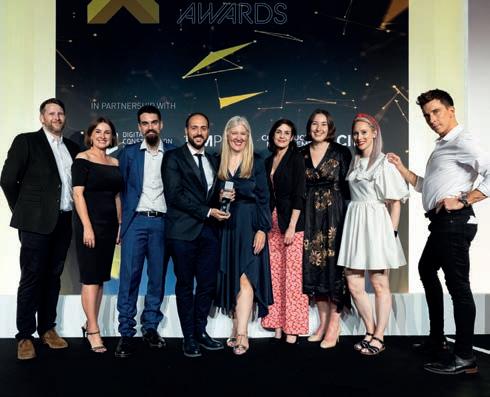
The solution is innovative and relevant. This is a real challenge solved using technology that exists in other sectors but used to its absolute strengths in this practical example. It has positive impact on finances, time, safety and quality
Other shortlisted organisations
l Social Value Digital Hub – VINCI Construction UK l Digital progress tracking with automated reporting – Taylor Woodrow l Improving the operational performance of higher and further education buildings – Integrated Environmental Solutions with the University of Edinburgh and Schneider Electric l The Living Lab – Ethos Engineering l Royal Free London NHS Capital Projects PMO reporting tool – Royal Free London Property Services, in conjunction with Royal Free London NHS Foundation Trust and Turner & Townsend
Sponsored by

The Eurovia and Paperless Construction team receive their award from Russell Kane (far right) and sponsor Jonathan Moulam (second left) from the Association for Project Safety
Paperless Construction and Eurovia take health and safety award
Eurovia digitised its health and safety practices after a trial with Paperless Construction, helping the pair to win the Digital Innovation in Health, Safety & Wellbeing category, sponsored by the Association for Project Safety
Eurovia trialled Paperless
Construction on its Coventry City Council Retail Quarter project between March 2020 and October 2021.
As well as allowing Eurovia to digitise its construction activities, remove paper from its work processes and increase productivity, the technology allowed Eurovia to digitise health, safety and environmental compliance, including site briefings, checking training competencies, issuing permits to work and capturing exposure hours.
The change means that safety briefings are now recorded in a fraction of the time, with a full digital audit trail. With an easy-to-use mobile app, everyone on site now has access to their own training This demonstrated great examples and evidence of the benefits and achievements, and highlighted the opportunity for its use on future projects
What the judges said
records, and level-based access enables supervisors and site management to check all training records, competencies, fatigue hours and medical information through a simple search scanning QR codes.
Such was the success of the trial that Eurovia has now rolled out Paperless Construction to 120 of its projects. Nearly 6,000 user records and competencies have been digitised, and 500,000 working hours and 16,000 safety briefings recorded. Furthermore, data shows that supervisors save up to two hours per day, equivalent to a 20% efficiency gain.
Philip Reid, Eurovia Contracting’s digital operations manager, said: “It’s good that this has come out of Digital Construction Week because it was there where we first saw Raymond [Castelyn, founder of Paperless Construction], many years ago. After those first discussions, we’ve put Paperless Construction into all of our sites, across the board. It has improved safety, it has improved productivity, it has been great.”
Raymond Castelyn, founder of Paperless Construction, added: “There are those people who will say, ‘I’ve been doing it for 25 years on paper, why do you want me to change?’ But actually, we find that a month into it they’ll say, ‘this is great, this has saved me time, this has made my life better’.”
Other shortlisted organisations
l Fit For Work – fitforwork.ai l Rochdale Town Hall Project: Phase 1/1A – Safer Sphere with Rochdale Borough Council, Rochdale Development Agency and HH Smith Contractor l SkillShield – Make Real and Keltbray l The Living Lab – Ethos Engineering l UCL Pearl Project: A building to house the world – UCL Civil Engineering Dept & Estates Development Dept, Transport for London, with Penoyre & Prasad Architects, Aecom, Volker Fitzpatrick, Atkins, Turner & Townsend, Stantec, BIMSafe and Briggs & Forrester Facilities Management
Sponsored by
Skanska GeoBIM wins Digital Excellence award
Skanska’s platform, which integrates two data sets that are not natively interoperable, GIS and BIM, won the Digital Excellence in a Construction Business category, sponsored by Autodesk Construction Cloud

Skanska faces three key challenges to the effective introduction of digital twins in transport infrastructure: l interoperability – how to collate and analyse different data from different discipline; l location-enabling – the linear characteristics of infrastructure require geospatial intelligence to predict clashes and manage interfaces; and l connecting data, disciplines and organisations that enable holistic and integrated decision-making throughout the project life cycle.
The UK information mandate and the Geospatial Strategy aim to overcome these challenges, with geographic information science (GIS) and BIM being two promising data sources to realise a digital twin. However, GIS and BIM are not natively interoperable at a data, process or systems level.
As a result, Skanska created GeoBIM, a novel format- and software-agnostic geospatial solution that integrates GIS and BIM to enable the geospatial digital twin for infrastructure projects.
It focuses on the integration at a data and process level, enabling a bi-directional connection of the BIM and GEO common data environments (CDE). It is based on the ExtractTransform-Load process and Python.
The solution is capable of consuming a variety of file formats (.ifc, .rvt, .dwg, .dgn, .idgn, .skp, .las, .pod) directly from their native CDE (ProjectWise, BIM360), and manipulates the geometry, semantics and topology and loads the information to the GeoCDE. This is an automated process split in three parts: geometric conversion, semantic mapping and topological validation. The information is then shared to Skanska’s enterprise GIS ecosystem.
Now a fully deployed solution across road and rail mega-projects within Skanska Infrastructure, it has reduced the time spent finding the single source of truth by 99%.
Among benefits, it has generated a cost saving of approximately £100,000 per year based on 12-plus file formats that Skanska GeoBIM brings together agnostically.
George Floros, the GIS lead for Skanska UK – Infrastructure, said: “This is the beginning for us. We have a fantastic team and this award is testament to our innovation. It was bringing it all together and putting innovation into practice. It was about all the different disciplines coming together and embracing innovation.”
Excellent recognition of the reality that data needs to flow and not be constrained by system boundaries or type. This is going to help drive efficiency in the way projects are planned and visibility of information
What the judges said
The winning Skanska team receive their trophy from host Russell Kane (far right) and Michelle Jeffs (third right) from sponsor Autodesk Construction Cloud
Other shortlisted organisations
l AKT II software ecosystem Re.AKT – AKT II l BIM360 Escape the hospital – Hoare Lea l Digital Driven by Desire – Vinci Construction UK l SCS Innovation – Leaving a Legacy – Skanska Costain Strabag JV working with HS2 l Working Smart – Ardmac
